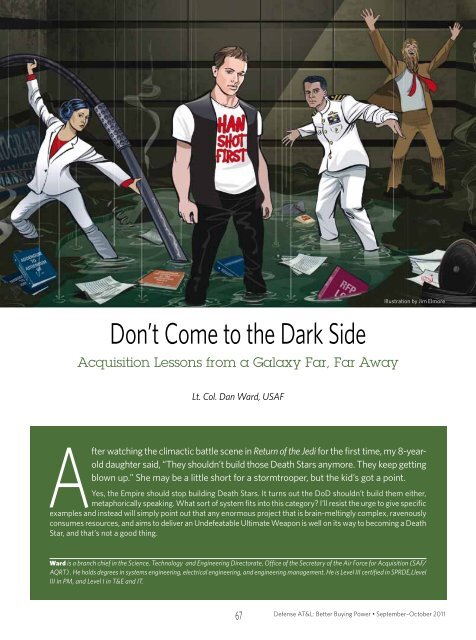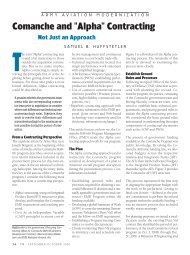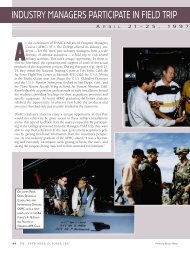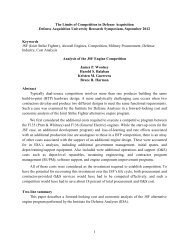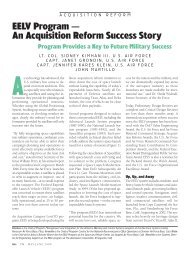Don't Come to the Dark Side - Defense Acquisition University
Don't Come to the Dark Side - Defense Acquisition University
Don't Come to the Dark Side - Defense Acquisition University
You also want an ePaper? Increase the reach of your titles
YUMPU automatically turns print PDFs into web optimized ePapers that Google loves.
Don’t <strong>Come</strong> <strong>to</strong> <strong>the</strong> <strong>Dark</strong> <strong>Side</strong><br />
<strong>Acquisition</strong> Lessons from a Galaxy Far, Far Away<br />
Lt. Col. Dan Ward, USAF<br />
67<br />
Illustration by Jim Elmore<br />
After watching <strong>the</strong> climactic battle scene in Return of <strong>the</strong> Jedi for <strong>the</strong> first time, my 8-yearold<br />
daughter said, “They shouldn’t build those Death Stars anymore. They keep getting<br />
blown up.” She may be a little short for a s<strong>to</strong>rmtrooper, but <strong>the</strong> kid’s got a point.<br />
Yes, <strong>the</strong> Empire should s<strong>to</strong>p building Death Stars. It turns out <strong>the</strong> DoD shouldn’t build <strong>the</strong>m ei<strong>the</strong>r,<br />
metaphorically speaking. What sort of system fits in<strong>to</strong> this category? I’ll resist <strong>the</strong> urge <strong>to</strong> give specific<br />
examples and instead will simply point out that any enormous project that is brain-meltingly complex, ravenously<br />
consumes resources, and aims <strong>to</strong> deliver an Undefeatable Ultimate Weapon is well on its way <strong>to</strong> becoming a Death<br />
Star, and that’s not a good thing.<br />
Ward is a branch chief in <strong>the</strong> Science, Technology and Engineering Direc<strong>to</strong>rate, Office of <strong>the</strong> Secretary of <strong>the</strong> Air Force for <strong>Acquisition</strong> (SAF/<br />
AQRT) . He holds degrees in systems engineering, electrical engineering, and engineering management. He is Level III certified in SPRDE,Llevel<br />
III in PM, and Level I in T&E and IT.<br />
<strong>Defense</strong> AT&L: Better Buying Power • September–Oc<strong>to</strong>ber 2011
More than one writer<br />
inexplicably complimented<br />
Vader’s leadership style,<br />
conveniently overlooking his use<br />
of telekinetic strangulation<br />
as a primary motivational<br />
approach.<br />
Why are Death Stars a bad idea? The main objections fit in<strong>to</strong><br />
two categories: operational and programmatic. The operational<br />
shortcomings of <strong>the</strong> Empire’s doomed battlestations<br />
are well known and widely mocked. Their programmatic shortcomings<br />
are less well known but worth considering. We’ll take<br />
a look at both categories.<br />
Death Star Operational Assessment<br />
Introduced in Episode IV, A New Hope, <strong>the</strong> Death Star makes an<br />
impressive debut when it vaporizes <strong>the</strong> planet Alderaan—<strong>the</strong><br />
one and only time it fires its main weapon. Shortly <strong>the</strong>reafter,<br />
<strong>the</strong> entire station, with 1.2 million people on board, is destroyed<br />
by a single shot fired by a half-trained Jedi. That’s what we<br />
call a critical vulnerability, and it’s <strong>the</strong> subject of relentless fan<br />
disdain. The second Death Star’s performance in combat was<br />
even less impressive. Despite being much larger than <strong>the</strong> original<br />
one, it was dispatched by <strong>the</strong> rebels before firing its planetbusting<br />
laser even once. So much for being “fully operational.”<br />
To be sure, <strong>the</strong> Death Star is primarily a weapon of intimidation<br />
ra<strong>the</strong>r than something <strong>to</strong> be used all willy-nilly. Even <strong>the</strong><br />
Evil Empire didn’t want <strong>to</strong> demolish more than a handful of<br />
planets. So <strong>the</strong> fact that <strong>the</strong> Death Star only ever fired one<br />
shot may not be that big of a deal. However, <strong>the</strong> fact that <strong>the</strong><br />
stations kept getting blown up is a big deal indeed. It’s hard <strong>to</strong><br />
be intimidating if you’re a smoking cloud of debris.<br />
One might wonder how such an ostensibly powerful weapon<br />
could have such a consistently poor track record and such a<br />
gaping weakness. Despite <strong>the</strong> opinion of certain critics, <strong>the</strong>se<br />
shortcomings are not a cheap plot device by a lazy writer. In<br />
<strong>Defense</strong> AT&L: Better Buying Power • September–Oc<strong>to</strong>ber 2011 68<br />
fact, <strong>the</strong> Death Star’s combination of inadequacy and vulnerability<br />
may be <strong>the</strong> second-most realistic aspect of <strong>the</strong> entire<br />
saga.<br />
Build Them, Do Not<br />
From a design perspective, a system as enormously complex<br />
as a Death Star is more than any program manager or senior<br />
architect can handle, no matter how high <strong>the</strong>ir midi-chlorian<br />
count is. There is bound <strong>to</strong> be an overlooked exhaust vent<br />
or two that leads directly <strong>to</strong> <strong>the</strong> reac<strong>to</strong>r core. That is just <strong>the</strong><br />
sort of vulnerability an asymmetric opponent can exploit. In<br />
my professional engineering judgment, a flaw of this type was<br />
inevitable. As C-3PO would say, <strong>the</strong> possibility of building such<br />
a large and complex system without overlooking something<br />
critical is approximately 3,720 <strong>to</strong> 1! The resulting error may<br />
not be as dramatic as George Lucas envisioned, but even a<br />
malfunction in <strong>the</strong> life support system or navigation software<br />
can be pretty exciting in its own way.<br />
Death Star Programmatics<br />
The Death Star’s lackluster contribution <strong>to</strong> <strong>the</strong> fight is reason<br />
enough not <strong>to</strong> build one, but serious problems emerged long<br />
before it was declared operational. In Return of <strong>the</strong> Jedi, viewers<br />
gain a fascinating insight in<strong>to</strong> <strong>the</strong> programmatics of Empire<br />
acquisitions. In <strong>the</strong> single most realistic scene in <strong>the</strong> whole<br />
double-trilogy, Darth Vader complains that <strong>the</strong> second Death<br />
Star construction project is … behind schedule. In fact, much<br />
of <strong>the</strong> drama in Episode VI revolves around this delay.<br />
Consider <strong>the</strong> implications of pop culture’s most no<strong>to</strong>rious<br />
schedule overrun. In <strong>the</strong> Star Wars universe, robots are selfaware,<br />
every ship has its own gravity, Jedi Knights use <strong>the</strong><br />
Force, tiny green Muppets are formidable warriors and a piece<br />
of junk like <strong>the</strong> Millennium Falcon can make <strong>the</strong> Kessel Run in<br />
less than 12 parsecs. But even <strong>the</strong> florid imagination of George<br />
Lucas could not envision a project like <strong>the</strong> Death Star coming<br />
in on time, on budget. He knew it would take a Jedi mind trick<br />
beyond <strong>the</strong> skill of Master Yoda <strong>to</strong> make an audience suspend<br />
that much disbelief.<br />
Even worse, it turns out getting a moon-sized project back<br />
on track requires <strong>the</strong> personal presence of a Sith Lord. Let<br />
me assure you, if your project’s success depends on hiring<br />
someone whose first name is Darth, you’ve got a problem. Not<br />
just because Sith Lords are make-believe, but also because<br />
<strong>the</strong>y’re evil.<br />
I’ve Got A Bad Feeling About This<br />
If you count <strong>the</strong> 14 hours I spent rewatching all six movies, I<br />
did way more research for this article than any o<strong>the</strong>r project<br />
in recent memory. During <strong>the</strong> phase of research that did not<br />
involve popcorn, I was surprised <strong>to</strong> discover several blogs and<br />
published articles praising Darth Vader for his programmatic<br />
prowess.<br />
You’d think it would go without saying that Vader is not a great<br />
example of anything o<strong>the</strong>r than redemption. From <strong>the</strong> time he
puts on that black helmet until his (spoiler alert!) heart-warming<br />
death scene, he’s a complete baddie. And yet, it turns out<br />
many fans have drawn unfortunate lessons from this character.<br />
An article in Project Magazine titled “If His Day Rate Is Reasonable,<br />
Get Darth Vader” commended Vader’s ability <strong>to</strong> turn<br />
around an ailing project. Ano<strong>the</strong>r program management professional<br />
wistfully wrote, “If only most project managers could<br />
have <strong>the</strong> presence and command <strong>the</strong> respect that Darth Vader<br />
did…” Um, have you seen <strong>the</strong>se films? I don’t think we really<br />
want PMs <strong>to</strong> walk around in capes and black armor. Sure, I’ve<br />
known people who thought <strong>the</strong>y were on par with Vader, but<br />
I assure you, his path is not one we should follow. I’m pretty<br />
sure it leads <strong>to</strong> suffering.<br />
A few writers praised Vader’s strong communication skills,<br />
pointing out that he conscientiously “ensured <strong>the</strong> Emperor was<br />
kept up-<strong>to</strong>-date with regular progress reports.” In a similar<br />
vein, I’m <strong>to</strong>ld Mussolini kept <strong>the</strong> trains running on time. Even<br />
if that were true (and it’s not), it doesn’t make him a good role<br />
model.<br />
More than one writer inexplicably complimented Vader’s leadership<br />
style, conveniently overlooking his use of telekinetic<br />
strangulation as a primary motivational approach. One misguided<br />
soul described Vader as “an authoritative figure who<br />
commanded respect.” A more accurate description might be<br />
“a murderous tyrant who commanded obedience.” There’s a<br />
difference.<br />
Happily, a blog commenter with <strong>the</strong> unlikely nom de net of<br />
Luke had <strong>the</strong> wisdom <strong>to</strong> point out, “All projects developed by<br />
<strong>Dark</strong> Lords will end up like <strong>the</strong> Death Stars.” By that I presume<br />
he meant “glowing fields of space junk,” but it’s possible he<br />
also meant “over budget, behind schedule and blown-up before<br />
Act II.” Online Luke is probably right: <strong>Dark</strong> Lords build<br />
Death Stars. I suspect <strong>the</strong> inverse is also true—building Death<br />
Stars makes program managers end up like <strong>Dark</strong> Lords. If so,<br />
that’s one more reason not <strong>to</strong> do it.<br />
A Jedi Craves Not These Things<br />
Now, <strong>the</strong> commentaries I quoted were surely at least partially<br />
<strong>to</strong>ngue-in-cheek. However, <strong>the</strong>re seemed <strong>to</strong> be a sincere underlying<br />
belief in many cases that a) <strong>the</strong> Death Stars were<br />
awesome engineering projects and b) Darth Vader was a good<br />
leader who got stuff done. I can excuse enthusiastic fanboys<br />
and fangirls for holding <strong>the</strong>se beliefs, but as professional military<br />
technologists, we know better.<br />
Consider <strong>the</strong> fact that even <strong>the</strong> Empire, with all its vast resources<br />
and <strong>the</strong> full power of <strong>the</strong> <strong>Dark</strong> <strong>Side</strong>, could only build<br />
one Death Star at a time. Building two at once was clearly more<br />
than it could handle. This reminds me of Norm Augustine’s<br />
famous prediction that at some point, <strong>the</strong> entire DoD budget<br />
would purchase just one aircraft for all <strong>the</strong> Services <strong>to</strong> share.<br />
The Empire apparently arrived at this singularity long, long ago.<br />
I’m not convinced this achievement represented real progress.<br />
69<br />
A Death Star is an Empire<br />
weapon that aims <strong>to</strong><br />
intimidate opponents in<strong>to</strong><br />
submission. Droids are<br />
Republic technology. They don’t<br />
intimidate anyone. Instead, <strong>the</strong>y<br />
earn <strong>the</strong>ir keep by being useful<br />
and practical.<br />
The truth is, Death Stars are about as practical as a metal<br />
bikini. Sure, <strong>the</strong>y look cool, but <strong>the</strong>y aren’t very sensible. Specifically,<br />
Death Stars can’t possibly be built on time or on budget,<br />
require pathological leadership styles and, as we’ve noted,<br />
keep getting blown up. Also, nobody can build enough of <strong>the</strong>m<br />
<strong>to</strong> make a real difference in <strong>the</strong> field.<br />
The bot<strong>to</strong>m line: Death Stars are unaffordable. Whe<strong>the</strong>r we’re<br />
talking about a fictional galaxy far, far away or <strong>the</strong> all <strong>to</strong>o real<br />
conditions here on Planet Earth, a Death Star program will<br />
cost more than it is worth. The investment on this scale is unsustainable<br />
and is completely lost when a wamp-rat-hunting<br />
farmboy takes a lucky shot. When one station represents <strong>the</strong><br />
entire fleet (or even 5 percent of <strong>the</strong> fleet), we’ve put <strong>to</strong>o many<br />
eggs in that basket and are well on our way <strong>to</strong> failing someone<br />
for <strong>the</strong> last time.<br />
The answer isn’t <strong>to</strong> build more, partly because we can’t and<br />
partly because <strong>the</strong> underlying concept is so critically flawed.<br />
Instead of building Death Stars, we should imitate <strong>the</strong> most<br />
successful technology in <strong>the</strong> saga: R2-D2.<br />
The Droids We’re Looking For<br />
My extensive research uncovered an interview where George<br />
Lucas identified R2-D2 as “<strong>the</strong> hero of <strong>the</strong> whole thing.” I found<br />
this comment startling at first, because in all my boyhood<br />
hours of playing Star Wars, nobody ever wanted <strong>to</strong> be an astromech<br />
droid. We all wanted <strong>to</strong> be Luke. And yet, a closer look<br />
at <strong>the</strong> films shows Ar<strong>to</strong>o has an impressive tendency <strong>to</strong> save<br />
<strong>the</strong> day, in scene after scene. Whe<strong>the</strong>r it’s repairing <strong>the</strong> Millennium<br />
Falcon’s hyperdrive, destroying a pair of Super Battle<br />
Droids, conveying a secret message <strong>to</strong> old Ben Kenobi or de-<br />
<strong>Defense</strong> AT&L: Better Buying Power • September–Oc<strong>to</strong>ber 2011
livering Luke’s light saber at <strong>the</strong> critical moment on Jabba’s Sail<br />
Barge, he’s always got a trick up his proverbial sleeve.<br />
When a young Anakin snuck Padme off Coruscant and reassured<br />
her by saying “Don’t worry, we have Ar<strong>to</strong>o with us,” he<br />
was not being ironic. No o<strong>the</strong>r character, biological or mechanical,<br />
is quite so dependable. If I was assaulting a Death Star in<br />
an X-wing fighter, you bet I’d want a good R2 unit on board.<br />
Our Only Hope<br />
Yes, <strong>the</strong>re are plenty of flaws in <strong>the</strong> Star Wars films—I’m looking<br />
at you, Jar Jar Binks—but casting R2-D2 as <strong>the</strong> hero isn’t<br />
one of <strong>the</strong>m. Just as <strong>the</strong> Death Stars’ vulnerability and inadequacy<br />
are perfectly realistic, <strong>the</strong> superior operational performance<br />
of a simple droid corresponds <strong>to</strong> real-life experience.<br />
Time and again, war-winning weapons tend <strong>to</strong> be simple, inexpensive<br />
and small.<br />
An astromech droid’s simplicity makes it reliable, and its long<br />
his<strong>to</strong>ry of use in battle makes it robust and widely useful.<br />
Consider Ar<strong>to</strong>o’s restrained design. He doesn’t have fancy<br />
language processors; beeps and squeaks suffice. He doesn’t<br />
have arms or even a face. Ar<strong>to</strong>o is pure function. He has no<br />
unnecessary features, no superfluous parts. He’s not even very<br />
tall, proving once again Yoda’s dictum that size matters not.<br />
Consider this: A Death Star is an Empire weapon that aims <strong>to</strong><br />
intimidate opponents in<strong>to</strong> submission. Droids are Republic<br />
technology. They don’t intimidate anyone. Instead, <strong>the</strong>y earn<br />
DAU Alumni Association<br />
<strong>Defense</strong> AT&L: Better Buying Power • September–Oc<strong>to</strong>ber 2011 70<br />
<strong>the</strong>ir keep by being useful and practical. Droids are about finesse,<br />
while Death Stars are about brute force. And given <strong>the</strong><br />
current world situation, finesse is clearly what we need.<br />
Droids aren’t expensive; <strong>the</strong>ir requirements aren’t overstated.<br />
One might argue that a droid can’t do what a Death Star does,<br />
but <strong>the</strong>n again, <strong>the</strong> Death Stars didn’t do very much when all<br />
was said and done. In <strong>the</strong> final accounting, a droid like Ar<strong>to</strong>o<br />
does more than it was designed <strong>to</strong> do, while a Death Star ends<br />
up doing less. Much less.<br />
If you want <strong>to</strong> keep your limbs intact, let <strong>the</strong> Wookie win. And<br />
if you want <strong>to</strong> develop and deliver effective weapon systems,<br />
build droids instead of Death Stars. The key is exercising design<br />
restraint, focusing our requirements on <strong>the</strong> essential requirements<br />
ra<strong>the</strong>r than <strong>the</strong> endless list of desirements, living<br />
within our budget and resisting <strong>the</strong> temptation <strong>to</strong> extend <strong>the</strong><br />
schedule. Sure, it’s hard <strong>to</strong> tell <strong>the</strong> Emperor no when he insists<br />
on building yet ano<strong>the</strong>r Death Star, but since <strong>the</strong> Force is imaginary,<br />
chances are good you won’t get zapped with lightning<br />
for suggesting an alternative approach.<br />
There are all sorts of ways <strong>to</strong> simplify a design, <strong>to</strong> reduce a set<br />
of requirements <strong>to</strong> <strong>the</strong> bare minimum, <strong>to</strong> make sure we build<br />
what we can afford. Don’t believe such a thing can be done?<br />
That is why you fail. But those who do believe will find <strong>the</strong><br />
system <strong>the</strong>y built just might be “<strong>the</strong> hero of <strong>the</strong> whole thing.”<br />
The author can be contacted at daniel.ward@pentagon.af.mil.<br />
Join The SucceSS neTwork<br />
The DAU Alumni Association opens <strong>the</strong> door <strong>to</strong> a worldwide network of <strong>Defense</strong><br />
<strong>Acquisition</strong> <strong>University</strong> graduates, faculty, staff members, and defense industry<br />
representatives—all ready <strong>to</strong> share <strong>the</strong>ir expertise with you and benefit from yours.<br />
Be part of a two-way exchange of information with o<strong>the</strong>r acquisition professionals.<br />
• Stay connected <strong>to</strong> DAU and link <strong>to</strong> o<strong>the</strong>r professional organizations.<br />
• Keep up <strong>to</strong> date on evolving defense acquisition policies and developments<br />
through DAUAA newsletters and symposium papers.<br />
• Attend <strong>the</strong> DAUAA Annual <strong>Acquisition</strong> Community Conference/ Symposium<br />
and earn Continuous Learning Points (CLPs) <strong>to</strong>ward DoD continuing education<br />
requirements.<br />
Membership is open <strong>to</strong> all DAU graduates, faculty, staff, and defense industry<br />
members. It’s easy <strong>to</strong> join, right from <strong>the</strong> DAUAA Web site at www.dauaa.org.<br />
For more information,<br />
call 703-960-6802 or 800-755-8805, or e-mail dauaa2(at)aol.com.


